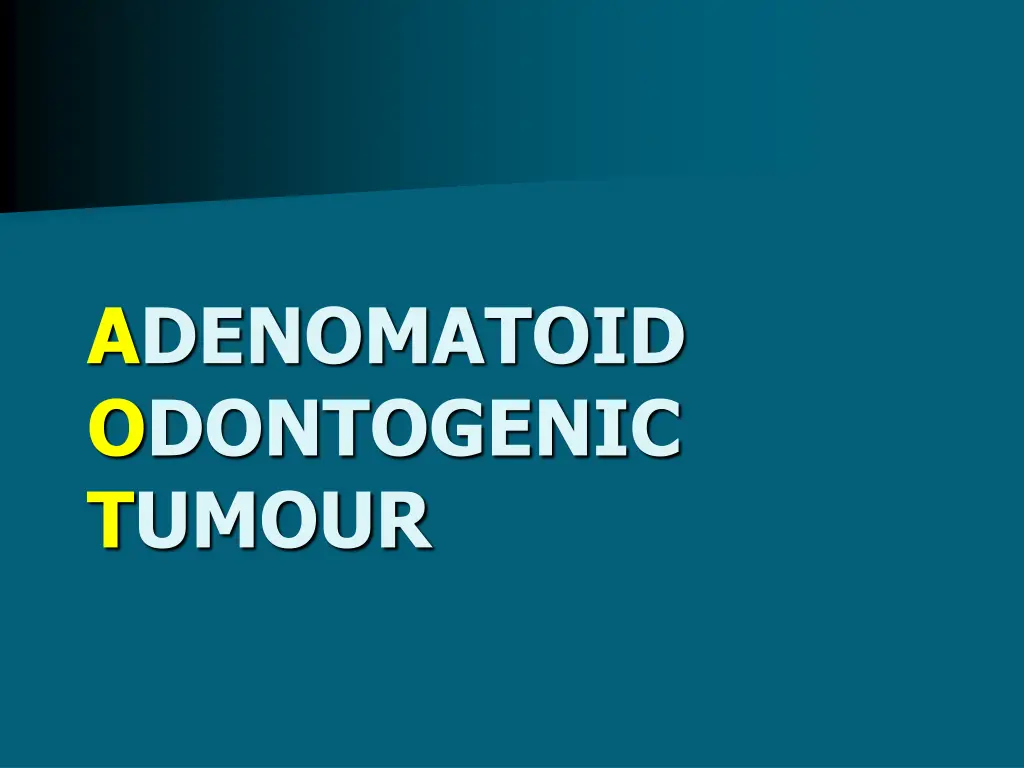
Adenomatoid Odontogenic Tumour: Clinical Features, Radiological Findings, and Differential Diagnosis
Learn about adenomatoid odontogenic tumor, a benign lesion primarily affecting young females in the anterior aspect of the maxilla. Discover its clinical features, radiological appearance, histological features, and differential diagnosis with other jaw lesions like unicystic ameloblastoma and calcifying epithelial odontogenic tumor (CEOT). Treatment options and prognosis are also discussed.
Download Presentation

Please find below an Image/Link to download the presentation.
The content on the website is provided AS IS for your information and personal use only. It may not be sold, licensed, or shared on other websites without obtaining consent from the author. If you encounter any issues during the download, it is possible that the publisher has removed the file from their server.
You are allowed to download the files provided on this website for personal or commercial use, subject to the condition that they are used lawfully. All files are the property of their respective owners.
The content on the website is provided AS IS for your information and personal use only. It may not be sold, licensed, or shared on other websites without obtaining consent from the author.
E N D
Presentation Transcript
ADENOMATOID ODONTOGENIC TUMOUR
Earlier, believed to be a variant of Ameloblastoma with glandular elements and was referred to as ADENOAMELOBLASTOMA.
CLINICAL FEATURES: Age incidence: Young individuals, 1st& 2nd Sex incidence: More in females, twice more. Site predilection: Anterior aspect of maxilla.
Signs & symptoms: Small,asymptomatic lesion. Discovered accidentally during routine dental X-ray examination to ascertain unerupted tooth. Larger lesions jaw expansion cause for cause
RADIOLOGICAL FEATURES: Typical well defined unilocular lucency attached to an impacted / unerupted tooth, usually canine (FOLLICULAR VARIETY) Lucency extends past cervical region & must be distinguished from dentigerous cyst.
Extrafollicular well defined lucency not related to unerupted tooth. In both cases, lucency may contain snowflake like radio opacities.
DIFFERENTIAL DIAGNOSIS: Radiographic appearance can suggest following lesions for provisional diagnosis - 1. Unicystic ameloblastoma 2. CEOT 3. COC
HISTOLOGICAL FEATURES: Thick capsule Lesion is composed of spindle shaped epithelial cells that form sheets, strands or whorls in a scanty stroma.
Rosette like structures may show a central space which may be empty or contain some eosinophilic amyloid like material. Tubular duct like spaces are also seen which show a central space surrounded by columnar cells
Treatment & Prognosis Benign Capsule Recurrence : rare
CALCIFYING EPITHELIAL ODONTOGENIC TUMOUR (PINDBORG TUMOR)
Rare tumor, accounts for > 1% of all odontogenic tumors. Although odontogenic in origin, its histogenesis is uncertain. Tumor cells strongly resemble stratum intermedium of dental organ.
CLINICAL FEATURES: Age incidence: 3rdto 5thdecades. Sex incidence: Equal. Site predilection: 75% cases occur in posterior mandible. Signs & symptoms: Asymptomatic, slowly growing swelling.
RADIOLOGICAL FEATURES: Commonly well uni/multilocular usually associated with an impacted tooth. Lesion may presence of radiopaque material within the lucency. appears as a defined, scalloped, lucency, also show scattered
DIFFERENTIAL DIAGNOSIS: 1. Odontogenic cysts like dentigerous, OKC, etc. 2. Odontogenic tumors like Ameloblastoma, etc. 3. Other bony lesion like Central giant cell granuloma, Aneurismal bone cyst etc.
HISTOLOGICAL FEATURES: Tumor shows discrete islands / polyhedral cells in stroma. Nuclei show lot of size variation, nuclei can be seen. sheets epithelial a fibrous of even giant
Tumor islands also enclose large areas of eosinophilic, amorphous, amyloid like material
The cell outlines of tumor epithelial cells are distinct and intercellular bridges may be noted. The amyloid like material usually calcifies to form concentric rings (LEISEGANG RINGS).
Most common odontogenic tumor. Considered hamartomas, rather than neoplasm. In a fully developed odontoma, mainly enamel and dentin along with variable amounts of pulp and cementum are seen.
CLASSIFICATION: - Odontomas are further sub classified into - COMPOUND ODONTOMA - COMPLEX ODONTOMA Both occur with equal frequency. Compound composed of multiple, small, tooth like structures. Complex composed of conglomerate mass of enamel and dentin with no anatomic relationship to tooth.
CLINICAL FEATURES : - Age incidence: First 2 decades. Sex incidence: None. Site predilection: Anterior maxilla. Signs & symptoms: Mostly asymptomatic, small, seldom exceeding the size of tooth missing in the region. Larger lesions may cause jaw expansion.
ODONTOMA (COMPOUND) Gross pathological specimen showing a mass of more than 20 tooth like malformed structures.
ODONTOMA (COMPOUND) RADIOLOGICAL FEATURES: - This type is composed of multiple, small tooth like structures. The entire mass appears surrounded by a radiolucent rim. An unerupted tooth is usually associated with both types of odontomes which impedes normal eruption of the tooth.
ODONTOMA (COMPLEX) RADIOLOGICAL FEATURES: Complex odontoma comprises of a single conglomerate mass of tooth like material. It bears no anatomic resemblance to any tooth. Appears as a opaque mass surrounded by a narrow lucent rim.
ODONTOMA (COMPOUND) HISTOLOGICAL FEATURES: - Microscopically, it shows discrete tooth like denticles in a fibrous stroma. Being a decalcified specimen, enamel appears as spaces around normal looking dentin and pulp which bear normal anatomic relationship to each other.
ODONTOMA (COMPLEX) HISTOLOGICAL FEATURES: - Consist of largely tubular dentin enclosing clefts / hollow circular spaces that contained enamel prior to decalcification. Thin layer of cementum sometimes may be present at the periphery.
Calcifying Epithelial Odontogenic Tumor (Pindborg Tumor) Uncommon (less than 200 cases reported to date) Radiolucent lesion with calcified radiopacities inside (calcifications are most often seen in association with an impacted tooth) Tx: local resection Protein in the amyloid areas is a new, recently discovered protein *With Congo Red stain the lesion will exhibit apple-green bifringence when viewed with polarized light
Ameloblastic Fibroma Tumor of both ectodermal and epithelial layers Younger patients Not generally aggressive, easily removed if discovered and treated early If the lesion contains calcifications, then it is an Ameloblastic Fibro-odontoma
Odontoma Tooth tumor mixed odontogenic tumor A.) Compound: look like little teeth, tooth material is in correct relation B.) Complex: everything mixed together, no normal relation of tooth material Tx: simple local excision prognosis is excellent
A. B.
Odontogenic Myxoma soap bubble appearance aggressive- may displace or cause resorption of teeth Derived from odontogenic ectomesenchyme Tx: small lesions can be treated by curattage, but since the lesion is not encapsulated, the site should be closely monitored, and large lesions may require more extensive resection. Hisologically odontogenic myxomas look just like dental papilla








